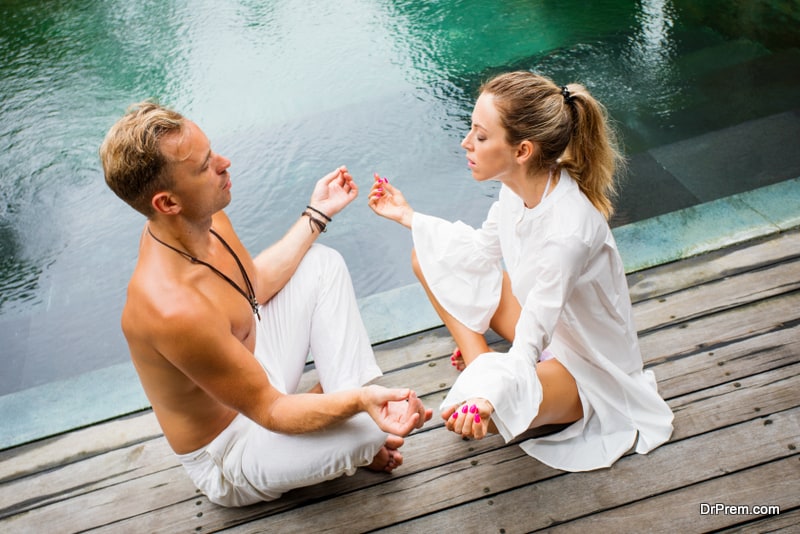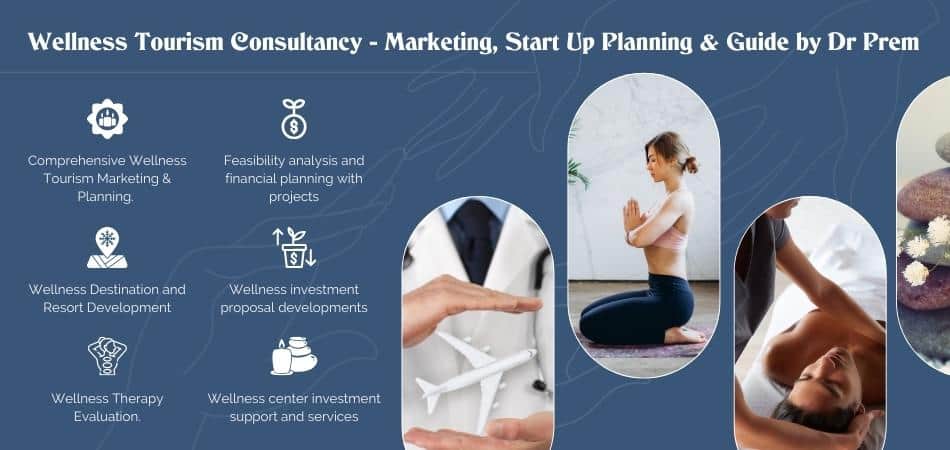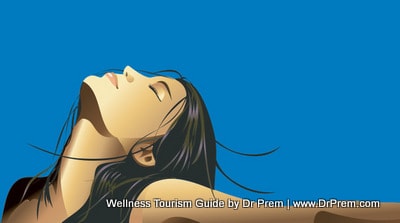Anna Guchok Bilous, a holistic speaker in the field of medical and wellness tourism gave a compelling speech and shared some valuable insights pertaining to the field. Let’s go through some key points covered in that speech.
Wellness tourism a booming industry in the eyes of an expert
-
Wellness cannabis to boom in post-covid wellness travel
-
Four key factors that are promoting the growth of wellness tourism can be classified as follows
-
Understanding the health and psychological benefits of wellness tourism
-
Health benefits of wellness tourism
-
Psychological benefits of wellness tourism
-
Interesting trends in wellness tourism
-
Nature Immersion Getaways
-
Preventative Wellness
-
Active Lifestyle Retreats
-
Emotional Healing Holidays
-
Wellness Nutrition Retreats
-
Alternative Treatment Retreats
-
Menopause Retreats
-
Middle-Age Men Retreats
-
Fertility Retreats
-
The wellness economy consists of these five markets
-
Wellness Lifestyle Real Estate
-
Workplace Wellness
-
SPA Industry
-
Thermal and Mineral Springs
-
Wellness Tourism
-
Benefits of stakeholder collaboration in wellness tourism
-
Explosive growth
-
Emergence of newer wellness tourism destinations
-
Destination competitiveness increases
-
Long-term survival of the industry
-
Research and Innovation
-
Promotion and branding of a destination
Seldom will you come across people who are at peace with the life they are leading. The majority of us live a very hectic and stressful life. Our lifestyles push us towards mental burn out and cause various health problems. To get away from our lifestyle, we look for an escape that can rejuvenate us, help us fight our mental stress and restore our health. Wellness tourism is seeing tremendous growth over the years, as people are seeking to slip away from their routine and immerse themselves into something that can help them find their sense of calm.
In 2017, wellness tourism was a six hundred and thirty-nine billion-dollar industry.
People are more and more understanding of the need for mental wellbeing and spending on maintaining their mental, emotional and physical health.
There is an estimation that by 2020, the wellness tourism industry will be a one trillion dollar industry.
World travelers made 830 million wellness trips in 2017, representing 17% of all tourism revenues.
Wellness tourism to lead the recovery of the battered global tourism industry
According to UNTWO estimates, Covid-19 effect on tourism translates to a loss of US$320 billion with millions of tourism jobs at risk.
In the World Tourism Association survey with 4000 consumers from 48 countries and union territories, respondents showed a strong desire for wellness related travel.
Wellness cannabis to boom in post-covid wellness travel
Months of lockdown and restricted free movement have had a bad effect on general mental health. People are desperate to get fresh oxygen from outdoor activities through wellness tourism. Despite travel restrictions still on in many locations, wellness tourism is set to led the tourism recovery path. Given the prevailing mental stress from Covid-19, it is wellness tourism that can offer proper rest and relaxation in calm and tranquil environment. Experts also feel a great opportunity lies ahead for the wellness cannabis market in countries where it is legal given its positive impact on mental stress, anxiety, muscle tension and inflammation. Cannabis wellness and related tourism could be a great rehabilitation option for those who have gone through extreme levels of stress and tension.
Before understanding the different aspects of wellness tourism, let us first understand what wellness tourism is.
Wellness tourism is traveling with the purpose of promoting health and well-being through activities that are physical, psychological or spiritual in nature. It is traveling to understand and learn lifestyle practices that can make one’s life better.
People are going around the globe looking for peace and purpose. On average, an international tourist spends 15000 dollars per trip for wellness-related travel that is 53% more than a typical international tourist, on the other hand, a domestic tourist spends 609 dollars per trip for wellness-related travel that is according to the numbers 178% more than an average domestic tourist.
Four key factors that are promoting the growth of wellness tourism can be classified as follows:
- There is an awareness in society on the importance of mental health on your body and life. People are realizing that in order to live a happy and satisfying life, it is not only important to be physically fit, your mental wellbeing also plays a very important role. They are actively seeking to find ways where they can break free and be one with nature.
- There is a tremendous increase in issues related to mental health, mental illness and other factors that stress the mind are on the rise. According to the WHO (World Health Organisation), one in every four people is suffering from some kind of mental disorder. It estimates that there are 450 million people around the world that are suffering from a diagnosable mental health issue.
- The World Health Organization incorporated mental wellbeing and mental wellness as a part of its world health policy and are actively promoting it.
- Increase in demand for alternative treatments to treat various kinds of ailments. People are seeking new ways to improve their health and fight diseases.
The rising mental and emotional distress and the desire to look for an escape that can bring peace and wellbeing has made more and more people to travel with a purpose of wellness.
But what are people looking for when they plan a wellness getaway?
What are the different purposes people have in mind when they plan a wellness holiday?
And what are the different kinds of retreats available when it comes to wellness tourism?
Well, different people are looking for improving different aspects of their life. Some want to immerse themselves in silent meditation to try to find a purpose in their lives, while others want to drown in nature and have a detox from their digital and social life, while some only want to experience and adapt to a healthier way of living.
Understanding the health and psychological benefits of wellness tourism
Wellness usually used to mean a healthy balance of mind, spirit and body that results in an overall feeling of well-being. It refers to trips untaken by tourists with the principle purpose being to improve their health. Attaining good health by a healthy lifestyle is possibly the prime motive behind the wellness tourism. People travel from developed nations to take a break from their hectic schedules and unhealthy practices of city life and enjoy peaceful surroundings in the lap of nature.
Health benefits of wellness tourism
Countries like India, Sri Lanka and Japan arrange traditional healthcare facilities for wellness travelers. As a wellness tourist, if you are looking for a yoga resort, India is possibly the best destination to relax your body and soul. Science proves that a regular yoga session in the morning or evening can help you reduce the symptoms of common, unceasing and incurable diseases like AIDS. It can prevent asthma attacks without any medication and simple yoga asanas can help in reducing the nervousness better than medications.
There are many breathing exercises like “pranayama”, which helps the patients to cure their respiratory problems and relaxing exercises plays an important role in the treatment of high blood pressure. Yoga secretes act as natural painkillers by adapting the gate-controlling system in the body to reduce the body ache.
Psychological benefits of wellness tourism
Wellness can be defined as a positive emotional or mental state of a person that one can achieve by opting a healthy lifestyle, feeling good about oneself and taking the responsibility of his own health. It develops the self-esteem among travelers and motivates them to engage themselves in a wide range of health promoting activities or behavior.
Interesting trends in wellness tourism
1) Nature Immersion Getaways:
One of the leading trends in the wellness industry are getaways that give you a chance to immerse yourself in nature. These retreats are generally built in locations that are away from the hustle-bustle of the city. It allows you to live in the lap of nature. Generally for people who are looking for a break from their fast-paced life.
2) Preventative Wellness:
These wellness retreats help us with learning lifestyle choices that can save us from various cardiovascular diseases, chronic respiratory disease, diabetes, or cancer. They are called preventative wellness programs, to give an example of preventative wellness programs anti-tobacco holidays. People are also seeking retreats that help them with slowing down their aging process and increases their longevity.
3) Active Lifestyle Retreats
Transformative wellness retreats are retreats that teach you new kinds of activities. These practices can be incorporated in the day to day lifestyle. These retreats teach you activities and different methods of exercising that makes you healthy. They also include introducing new activities, like trekking and hiking. According to a report released by the wellness institute research department, sports + mindfulness can comprise of a most mindful retreat.
4) Emotional Healing Holidays
These retreats are designed to recharge your emotional batteries. They keep your emotional health in focus and help you with maintaining your emotional health. They offer lectures on stress management, coaching on emotional healing, and life healing.
5) Wellness Nutrition Retreats
These retreats offer knowledge on ways of eating healthy food. They teach you to cook in styles that keep the nutrition level of the food intact. They also teach you the nutrition levels of different food. Basically, it promotes you to eat a healthy diet, a diet that suits your mind and body and keeps them healthy.
6) Alternative Treatment Retreats
These retreats offer an alternate form of medication for the treatment of a disease. To consider as an example we can say Ayurveda retreats offer Ayurvedic solutions to problems like diabetes and certain types of cancer and cardiovascular diseases. People are aware of the negative effects of western medication and are looking for ways to heal their bodies without harming it further.
7) Menopause Retreats
Menopause is a very difficult time for women, they experience various unpleasant health conditions, to consider a few like hot flashes, mood swings and various hormonal changes that the body goes through. These retreats help women with different types of practices, diet, and medication that can ease the process for them.
8) Middle-Age Men Retreats
These are specific to males wellness programs that deal with different issues faced by middle-aged men.
9) Fertility Retreats:
These retreats design various activities and treatments that are necessary for fertility. They inform you about healthy diet practices and lifestyle practices that are helpful in improving fertility.
The wellness economy consists of these five markets:
1) Wellness Lifestyle Real Estate
According to the numbers, 1.5% of the global construction market comes from wellness lifestyle real estate. People are buying properties that provide them with a space where they can take part in healthy lifestyle practices.
2) Workplace Wellness
The annual market accounts for 50 billion dollars. More and more employers are understanding the need for mental health. They are encouraging employees to focus on their physical and mental health.
3) SPA Industry
It is a 100 billion dollar market employing more than 2.6 million workers. SPA day is a great way to relieve stress and rejuvenate yourself. It is a relaxing experience and has various health benefits.
4) Thermal and Mineral Springs
They employ more than 2 million workers globally. These springs have various health benefits, from treating various skin conditions to improving blood circulation. It also helps in reducing stress and induces sleep.
5) Wellness Tourism
As we have seen above, wellness tourism is a booming industry. According to an estimation, it is growing at a double rate to general tourism.
People are seeking mental peace and wellbeing, wellness tourists are ready to travel as long as it is required to find their mindfulness and wellbeing.
Benefits of stakeholder collaboration in wellness tourism
With the booming of wellness tourism industry, the prospects for investments have also risen accordingly. Investors are becoming even more interested in this particular industry as the incentives so attached are worth it. Wellness tourism industry offers great prospects to earn profits and this has been the major reason that the stakeholders have shown a prospective interest in the globalized wellness tourism industry. The collaboration of stakeholders to the working regime of the wellness tourism industry is known to have worked wonders for both the parties and has taken this industry to reach a newer horizon.
Benefits of stakeholder collaboration in the wellness tourism industry are:
Explosive growth:
The prospects for new growth open up for both the industry as well as the stakeholders of the industry worldwide.
Emergence of newer wellness tourism destinations:
As the stakeholders are collaborated from throughout the world, it becomes easier for newer destinations to join this much-touted industry and make the most of it in all regards.
Destination competitiveness increases:
Destinations compete with each other and earn that coveted top rank for themselves, as this will help them earn a major chunk of investment. Stakeholders always have their eyes on the destinations that perform better; this has been a major reason for competition to increase and quality services to improve.
Long-term survival of the industry:
The collaboration of stakeholders in the wellness tourism industry has increased the prospects to survive the fierce competition for a longer period. This has been possible because with the collaboration of the stakeholders, the availability of funds and capital that is needed to survive the competition is available without much of hassle and thus the prospects to survive this gruesome competition have increased tremendously.
Research and Innovation:
This collaboration has been of the utmost benefits to the industry because with this collaboration a think-tank is constantly at work trying to generate innovative ideas that can help grow wellness tourism industry even further.
Promotion and branding of a destination:
Collaboration of the stakeholders with the industry plays a very significant role in the promotion and branding off a particular place as a wellness tourism site. Stakeholders invest in destination that has the potential to generate huge revenues, more investors and stakeholders mean a better global image in respects of branding and promotion.























